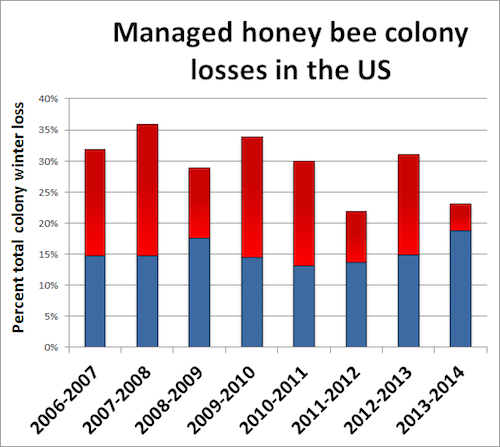USDA Reports Honeybee Death Rate Too High for Long-Term Survival
ENVIRONMENT, 9 Jun 2014
EcoWatch – TRANSCEND Media Service
Honeybees in the U.S. are dying at a rate too high to ensure their long-term survival, according to a new report from the U.S. Department of Agriculture (USDA).

This chart shows the total losses (red bars) of managed honeybee colonies in the U.S. over the past eight winters. The acceptable loss range (blue bars) is the average percentage of acceptable loss declared by honeybee colony managers for each of the eight winters. Credit: U.S. Department of Agriculture
Over the past winter—a season when honeybee hives are most vulnerable—the U.S. lost 23.2 percent of its hive honeybee population. That is lower than the previous winter’s 30.5 percent death rate, but the cumulative impact on honeybee populations over the past eight years poses a major threat to their long-term survival, as well as the country’s agricultural productivity, the USDA said.
Roughly one-quarter of U.S. crops depend on honeybees for pollination. “Yearly fluctuations in the rate of losses like these only demonstrate how complicated the whole issue of honey bee heath has become,” said a USDA researcher, citing factors such as viruses, pathogens, and pesticides.
One class of pesticides in particular, neonicotinoids, has been implicated in honeybee deaths. The European Union banned three widely used neonicotinoids last year, but they are still used in the U.S.
You Might Also Like:
Two New Studies Address the Ongoing Plight of Honeybees
7 PR Tricks Pesticide Companies Use to Spin Bee Crisis
24 Percent of Europe’s Bumblebees Threaten With Extinction
DISCLAIMER: The statements, views and opinions expressed in pieces republished here are solely those of the authors and do not necessarily represent those of TMS. In accordance with title 17 U.S.C. section 107, this material is distributed without profit to those who have expressed a prior interest in receiving the included information for research and educational purposes. TMS has no affiliation whatsoever with the originator of this article nor is TMS endorsed or sponsored by the originator. “GO TO ORIGINAL” links are provided as a convenience to our readers and allow for verification of authenticity. However, as originating pages are often updated by their originating host sites, the versions posted may not match the versions our readers view when clicking the “GO TO ORIGINAL” links. This site contains copyrighted material the use of which has not always been specifically authorized by the copyright owner. We are making such material available in our efforts to advance understanding of environmental, political, human rights, economic, democracy, scientific, and social justice issues, etc. We believe this constitutes a ‘fair use’ of any such copyrighted material as provided for in section 107 of the US Copyright Law. In accordance with Title 17 U.S.C. Section 107, the material on this site is distributed without profit to those who have expressed a prior interest in receiving the included information for research and educational purposes. For more information go to: http://www.law.cornell.edu/uscode/17/107.shtml. If you wish to use copyrighted material from this site for purposes of your own that go beyond ‘fair use’, you must obtain permission from the copyright owner.